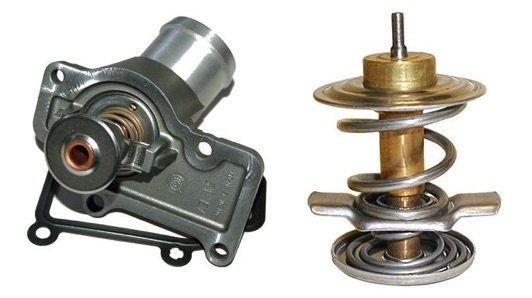
Published in the May 2018 issue of “Die Porsche Kassette”
Ⓒ2018 Technolab / PedrosGarage.com

For more information on aftermarket parts and more, please visit my website:
www PedrosGarage.com.
Happy Porsche'ing,

Few things tick me off more than seeing people getting ripped off by false promises.
This happens every single day and all around us. Every now and then I’ll get a call from someone who wants to find out more about a particular product for his Porsche, or better yet, wants to find out if a vendor’s claims are true, and the three most common are: High-flow air filters, Low-temp thermostats and high HP mufflers.
Let’s start with the first: High-Flow Air Filters. These are generally marketed as lifetime filters. They have a metallic screen mesh with woven in cotton fibers that are then impregnated with oil. They claim to improve automotive performance and increase HP because they flow more air.

But here’s the other side of the story.
If a filter passes more air than the OEM it means that it has larger holes. Larger holes also let more dirt through which is not good for the engine. Small droplets of the oil that impregnates the filter’s mesh and are supposed to catch the unwanted particles, get picked up by the incoming air and end up on the Mass Airflow Sensor’s surfaces, eventually damaging it or hampering its ability to “read” the correct amount of incoming air which is shared with the car’s computer in order to maintain the optimum mix of air/gas.
Their claims of better filtration are not real. You can do a simple test. Clean the inside of your car’s air intake system, from the air filter housing to the throttle body. Install a new OEM foam/paper filter and drive normally for 30 days. Inspect the intake system and wipe clean with some white-colored paper towels. Keep the used towels for later comparison. Now, with the intake clean again, install a new Hi-Flow, oiled air filter and again drive normally for 30 days. Go back and wipe clean your intake system with fresh white paper towels and compare with the previously used towels from the previous 30 days. I guarantee that you will clearly see the difference, in favor of the OEM foam/paper filter.
As per the more horsepower claims, the ONLY way to make more horsepower in an internal combustion engine is by passing more air through it. But the filter is NOT what dictates the amount of air that reaches the engine. That’s the function of the throttle body. The TB is the limiting or restricting piece in the flow of air. Making that claim is akin to saying that if you drink from a larger container you can drink more water. The amount of water you can drink is restricted by your throat’s size. You can’t drink more than your throat will pass even if you drank from a 5 gallon bucket.
So, why would anyone want to install an aftermarket filter that passes more dirt to the engine, fouls the MAF and doesn’t allow more air into the pistons?
Tandem to the Air Filters is usually a “cold air intake” kit.
First of all, all modern Porsches already have a cold air intake, meaning that the air that reaches the filter and then the engine comes from outside of the engine bay, hence “cold”. Many times these “cold air intakes” actually are the contrary as they allow hot air from the engine bay to get to the engine. The colder the air, the more dense it is and the more power it can make.
My second pet peeve is the Low Temp Thermostat. These claim that it will keep your Porsche’s engine running cooler and hence, better. It will do neither.
The thermostat in your house can keep the house cooler when you dial down the temperature. This is so because it keeps the A/C compressor running longer and pumping in more cold air.

But in your Porsche (or any water-cooled car for that matter) the thermostat doesn’t work that way. Automotive thermostats are a simple valve that can only be open or closed, period. When you start your cold Porsche in the morning, the thermostat is closed. It stays closed so that the small amount of coolant in the engine is circulated within the engine and can warm up to operating temperature quickly. Once this coolant reaches the optimal temp, lets say 185 degrees F, the thermostat opens and allows the coolant to travel to the radiators and back to the engine and maintain it’s optimal temperature. If you are stuck in traffic and there’s no airflow through the radiators you’ll notice the engine’s temp will rise a bit, so the car turns on its radiator fans to force air through the radiators and keep the coolant’s temp where it should be.
But installing a lower-temp thermostat, for instance, a 165 degree F, will not keep the engine cooler, in fact the only thing it will do is open before the engine reaches its operating temperature. After it gets to 165 degrees it stays open and has no more temperature-controlling ability. It’s up to the radiator fans and or your speed through the air to maintain the engines temp. So, why would anyone dish out their hard-earned money and install a generally more expensive thermostat that will just keep the car from warming up sooner?
Some of the vendors that offer these low temp thermostats will tell you that the OEM 185 degree thermostat won’t fully open until it reaches 200 degrees and that’s why you need the cooler one. If your thermostat takes that long to open, replace it with another OEM piece. Your car will appreciate it.
The third (and not the least) of my aftermarket pet peeves is the aftermarket mufflers that claim better horsepower because the have better air flow.
In the exhaust system, the only part that can effectively improve the car’s performance independently of the rest of the system is a set of equal length headers because they can reduce wasted energy from a standard exhaust manifold. But a muffler by itself (the silencers) can only modify the final sound you hear as the gasses flow out into the atmosphere. A super efficient muffler cannot improve your car’s airflow because, as we now know, that can only happen by installing a larger throttle body. What many aftermarket exhausts do for a Porsche is reduce its horsepower and introduce droning. There is a lot of acoustical work and engineering that goes into designing and manufacturing a sports car muffler and generally the OEM is the one that makes the best exhaust for a particular car. The original Porsche Sport Exhaust (PSE) is a superior product that I can highly endorse. It has valves that open or close depending on the engine’s performance and allow more gasses to bypass the muffler and thus free up backpressure. When the engine is not being taxed, the valves close and all is quiet.
There are several aftermarket brands that offer excellent exhaust systems as well, but they are very expensive since they are usually made from exotic materials such as carbon fiber, titanium, etc.
When purchasing performance products for your Porsche do your homework and don’t get ripped off.

